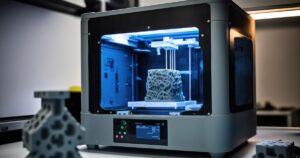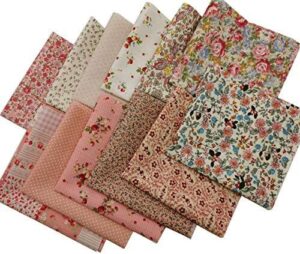3D printing, a technology that just a few years ago seemed limited to the realm of science fiction, is now establishing itself as a transformative force in a number of industries. As the world moves towards more efficient and sustainable solutions, recent advances in this area are sparking curiosity and innovation, challenging what we once thought possible. In this article, we'll dive into the latest innovations in 3D printing, exploring how they are shaping the future of manufacturing, from medicine to architecture, and the impact they may have on our daily lives. Get ready to discover a universe of possibilities that could redefine the way we create and consume.
Exploring New Materials in 3D Printing
The evolution of the materials used in 3D printing is revolutionizing the manufacturing and design sector. New compositions and techniques are allowing creators to explore previously unimaginable possibilities, broadening the horizons of innovation. Among the most exciting options are:
- Biodegradable filaments: Ideal for sustainable projects, these materials are gaining popularity because of their low environmental impact.
- Light metals: With their unique properties, these metals provide not only strength but also lightness, which is crucial in industries such as the automotive and aerospace industries.
- Multifunctional structures: Materials that combine electrical and mechanical properties, opening up space for new applications in electronic devices.
In addition to conventional filaments, research into hybrid compounds is on the rise, making it possible to print objects that combine different characteristics in a single product. The table below illustrates some of the new materials and their main properties:
| Material | Main property | Application |
|---|---|---|
| PLA | Biodegradable | Sustainable Products |
| ABS | Durable | Prototyping |
| PETG | Moisture resistant | Containers and Packaging |
| Nylon | High resistance | Mechanical parts |
Technological advances that transform the industry
3D printing has established itself as one of the most revolutionary technologies in modern industry, enabling the creation of prototypes and final products with unprecedented speed and precision. With the continuous improvement of raw materials, such as biodegradable plastics and advanced metals, the possibilities for application are expanding to various sectors, from automation to medicine. In addition, advances in computer modeling and scanning techniques have facilitated mass customization, allowing companies to meet specific demands efficiently and economically.
Another notable aspect is the innovations in the printing process. **Methods such as large-scale 3D printing are gaining prominence, enabling the production of complex and robust parts that were previously unfeasible. Below, we present some of these innovations and their implications:
| Innovation | Description | Impact |
|---|---|---|
| Multimaterial printing | Possibility of using different materials in a single object. | More functional and integrated pieces. |
| 4D printing | Objects that change shape after printing. | Applications in robotics and medicine. |
| AI integration | Using artificial intelligence to optimize designs. | Efficiency and innovation in product development. |
Sustainability and 3D Printing: Innovative Paths
3D printing is becoming a revolutionary tool for promoting sustainable practices in a variety of industries, from construction to fashion. The ability to produce objects on demand means that fewer materials are wasted, as well as enabling the use of **recycled materials**. Companies are investing in technologies that use plastics from waste, resulting in more environmentally friendly products. This change not only reduces environmental impact, but also challenges traditional manufacturing norms, encouraging a circular economy.
In addition, new printing methodologies, such as bioprinting, are emerging, enabling the creation of organic structures that can be used in both medicine and agriculture. The combination of biocompatibility and 3D printing opens doors to innovations such as the production ofartificial tissues and food printing. Below is a table showing some of the **benefits** of 3D printing in terms of sustainability:
| Benefits | Description |
|---|---|
| Waste Reduction | On-demand production minimizes material waste. |
| Circular Economy | Use of recycled and reusable materials. |
| Innovation in Materials | Development of plastics and biological compounds. |
| Access to technology | Facilitates access to customized and sustainable products. |

Applications Practices that Revolutionize Different Sectors
3D printing has transcended borders and become a real revolution in sectors such as health, construction and fashion. In medicine, for example, the printing of customized prostheses and specific anatomical models for surgery has significantly improved the results of procedures and patients' quality of life. Companies are using 3D printing to create artificial organs and tissuesThis has led to unprecedented advances in research into transplants and regenerative treatments. Furthermore, in architecture, the construction of structures with 3D printers has reduced construction time and material waste, promoting more sustainable development.
Fashion is also benefiting from innovation, with designers exploiting 3D printing to create unique, customized pieces that challenge the boundaries of traditional design. The ability to create complex textures and innovative shapes not only expands creativity, but also allows brands to meet specific consumer demands. In addition, this technology is being applied in food industry3D printers produce personalized food, optimizing nutrition and aesthetics. With all these applications, it is clear that 3D printing is not just a passing trend, but a tool that will shape the future of various sectors.
The Conclusion
As we wrap up our exploration of the latest innovations in 3D printing, it's clear that this technology continues to shape the future of various industries, from manufacturing to medicine. The ability to turn ideas into reality with precision and speed opens up a range of possibilities that we are only just beginning to unravel. From the creation of artificial organs to the construction of sustainable buildings, 3D printing is no longer a technological curiosity, but an essential tool for tackling contemporary challenges.
As we move towards an increasingly digital horizon, the collaboration between creativity and technology promises not only to revolutionize production, but also to rethink the way we interact with the world around us. We are invited to continue following this fascinating trajectory, where each printed layer is a step towards tomorrow. After all, in the world of 3D printing, the future is shaped layer by layer.



